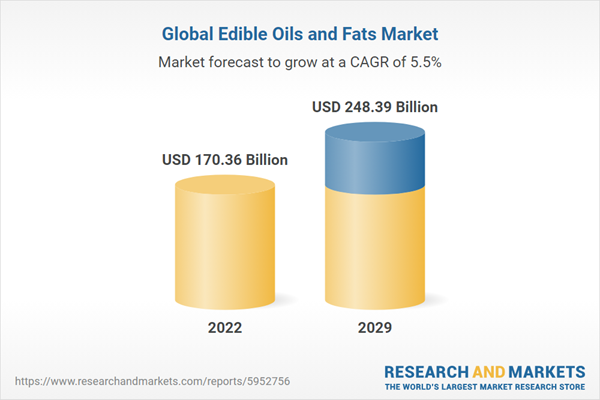The edible oils and fats market is evaluated at US$170.362 billion for the year 2022 growing at a CAGR of 5.53% reaching the market size of US$248.386 billion by the year 2029.
Foods made up of glycerides of fatty acids are classified as edible fats and oils. To generate uniformity in high-quality oil, edible oil products are purified using a variety of procedures such as degumming, bleaching, neutralizing, and deodorizing. Minor components, which are termed contaminants, are physically or chemically separated during the purification process. Animal fats must be derived from animals in good health at the time of slaughter and fit for human consumption, as established by a competent authority recognized in national legislation if they come from killed animals.MARKET DRIVERS:
Rising health awareness and rising population.
The rising attractiveness of healthy and fortified vegetable cooking oils, rising population, rising demand for food commodities, fortification of oils, rising consumer health concerns, and rapidly increasing industrial applications including personal care and cosmetics, are all factors driving market demand for vegetable-sourced fats and oils. Furthermore, the growing vegan population around the world is a driving force for vegetable fats and oils. Consumers are opting for healthier choices to maintain taste while increasing nutritional content, which is driving up demand for high-quality oils. Manufacturers are improving processing technology and expanding their product portfolios to suit this demand. Concerns about the negative effects of trans-fat consumption, such as an increased risk of type 2 diabetes, coronary heart disease, and brain stroke, are likely to encourage the use of vegetable oil as a cooking alternative.By type, the edible oil and fats market can be segmented into vegetable oils and edible fats.
The vegetable oil segment dominates the market. Further, the palm oil sub-segment is expected to dominate the vegetable oils segment. Many players from different regions, such as South Asia, are aggressively investing in palm tree plantations. In terms of production and market trade, palm oil is the most important vegetable oil. As it is exclusively produced in tropical locations, it has a very complicated environmental and social footprint. Owing to this, its use is considered to be the most widespread in global markets.The butter and margarine sub-segment under the edible fats segment is anticipated to account for the largest market share. Butter has been shown to improve immunity, boost metabolism, lower the risk of heart disease and blood pressure, and protect against gastrointestinal issues and conditions, among other things.
By form, the edible oil and fats market can be segmented into solid and liquid.
Fats and oils in liquid form are favored due to the ease of storage, transportation, and commerce. Different oils and fats have different levels of saturation over a wide range of temperatures. Certain oils, such as oleic acid, become liquid at temperatures much below room temperature, whereas elaidic acid remains solid even at higher temperatures.By application, the edible oil and fats market can be segmented into food applications and industrial applications.
The food applications segment is expected to dominate the market during the projected period. Fats and oils are used in a variety of items in the food industry, including chocolates and confectioneries, bakery products, processed foods, snacks, savories, and dairy products among others. Fats also help to build texture in cakes by aerating the dough. As a result, they are expected to have a bigger market share than industrial applications.The North American edible oil and fats market is anticipated to grow significantly.
Edible oils and fats are expected to expand at the quickest rate in the Asia Pacific area. Two important palm and palm kernel oil-producing countries, Indonesia and Malaysia are located in the region, as are two large fats and oils-consuming countries, including India and China. This is one of the major reasons why the Asia-Pacific region has the largest and fastest-growing fats and oils industry in the world.Key Developments:
- As announced by Cargill, Gemini PureitTM was launched in Karnataka in February 2023, reaffirming its aim to diversify its edible oils range and go as far south as possible. Customers will be able to purchase the Gemini PureitTM brand at shops in the four Southern states of Andhra Pradesh, Telangana, Karnataka, and Tamil Nadu.
- In December 2021, Fuji Specialties, Inc. and ITOCHU International Inc., a group company of ITOCHU Corporation with its headquarters located in New York, reached an agreement to establish a new joint venture company, Fuji Oil International Inc.
Segmentation:
By Type
- Vegetable Oil
- Soybean
- Sunflower
- Olive
- Palm
- Canola
- Others
- Edible Fats
- Butter and Margarine
- Lard
- Tallow & grease
- Others
By Form
- Liquid
- Solid
By Application
- Food applications
- Industrial applications
By Geography
- North America
- USA
- Canada
- Mexico
- South America
- Brazil
- Argentina
- Others
- Europe
- United Kingdom
- Germany
- France
- Italy
- Others
- Middle East and Africa
- Saudi Arabia
- Israel
- Others
- Asia Pacific
- China
- Japan
- India
- South Korea
- Indonesia
- Thailand
- Taiwan
- Others
Table of Contents
Companies Mentioned
- AAK International
- Archer Daniels Midland Company
- Bunge Limited
- Cargill, Incorporated
- Fuji Oil Co., Ltd.
- Mewah International Inc.
- Oleo Fats, Inc. (D&L Industries)
- Richardson International Limited
- Unilever Plc
- Vega Foods
- Wilmar International Limited
Table Information
| Report Attribute | Details |
|---|---|
| No. of Pages | 115 |
| Published | February 2024 |
| Forecast Period | 2022 - 2029 |
| Estimated Market Value ( USD | $ 170.36 Billion |
| Forecasted Market Value ( USD | $ 248.39 Billion |
| Compound Annual Growth Rate | 5.5% |
| Regions Covered | Global |
| No. of Companies Mentioned | 11 |









